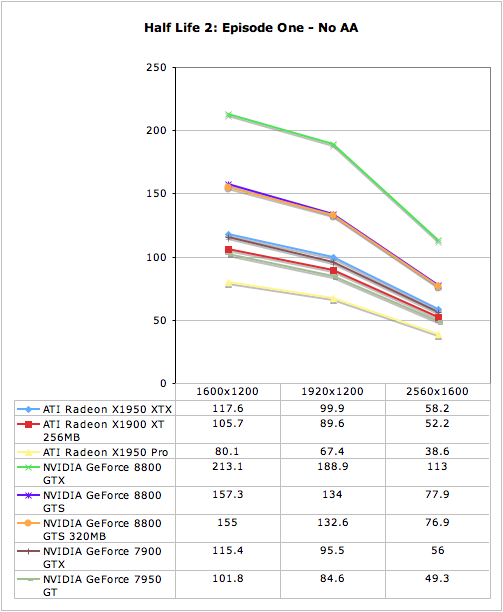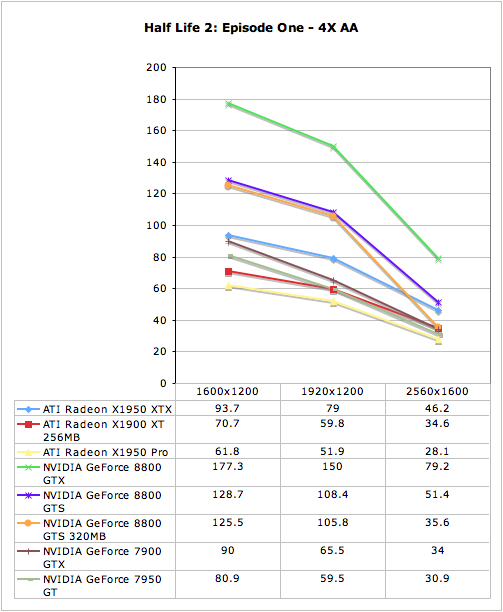Power Within Reach: NVIDIA's GeForce 8800 GTS 320MB
by Derek Wilson on February 12, 2007 9:00 AM EST- Posted in
- GPUs
Half-Life 2: Episode One Performance
Games based on Valve's Source engine have long been a staple of our test suites. Constantly evolving, HL2:EP1 show off some of the newer features of the engine. We are using the latest version of the game available on Steam as of the publication of this article. Our benchmark makes use of the timedemo functionality provided through Source. The demo we recorded is a battle with a flying gunship in a wooden house in which house and gunship are blown to bits. All the settings are turned up as high as they will go.


Half-Life 2: Episode One brings us another test where the extra 320MB of RAM the original 8800 GTS enjoys makes no difference when AA is not enabled. Performance between the two variants is identical here with all the settings but AA cranked up. Even at 2560x1600 there is no real difference, which is quite impressive for a card with less than 512MB of RAM.


Enabling 4xAA shows us that we can still get good performance at resolutions below 2560x1600 along with antialiasing. Up until our highest resolution test, the two 8800 GTS cards performed very similarly. This means that even at high resolutions with AA enabled, HL2:EP1 doesn't incur the same penalty on the 8800 GTS 320MB that other games do.
Games based on Valve's Source engine have long been a staple of our test suites. Constantly evolving, HL2:EP1 show off some of the newer features of the engine. We are using the latest version of the game available on Steam as of the publication of this article. Our benchmark makes use of the timedemo functionality provided through Source. The demo we recorded is a battle with a flying gunship in a wooden house in which house and gunship are blown to bits. All the settings are turned up as high as they will go.


Half-Life 2: Episode One brings us another test where the extra 320MB of RAM the original 8800 GTS enjoys makes no difference when AA is not enabled. Performance between the two variants is identical here with all the settings but AA cranked up. Even at 2560x1600 there is no real difference, which is quite impressive for a card with less than 512MB of RAM.


Enabling 4xAA shows us that we can still get good performance at resolutions below 2560x1600 along with antialiasing. Up until our highest resolution test, the two 8800 GTS cards performed very similarly. This means that even at high resolutions with AA enabled, HL2:EP1 doesn't incur the same penalty on the 8800 GTS 320MB that other games do.










55 Comments
View All Comments
Marlin1975 - Monday, February 12, 2007 - link
Whats up with all the super high resolutions? Most people are running 19inch LCDs that = 1280 X 1024. How about some comparisions at that resolution?poohbear - Tuesday, February 13, 2007 - link
have to agree here, most people game @ 12x10, especially people looking @ this price segment. Once i saw the graphcs w/ only 16x12+ i didnt even think the stuff applies to me. CPU influence is`nt really a factor except for 1024x768 and below, i`ve seen plenty of graphs that demonstrate that w/ oblivion. a faster cpu didnt show any diff until u tested @ 1024x768, 12x10 didnt show much of a diff between an AMD +3500 and a fx60 @ that resolution (maybe 5-10fps). please try to include atleast 12x10 for most of us gamers @ that rez.:)thanks for a good review nonetheless.:)DigitalFreak - Monday, February 12, 2007 - link
WHY didn't you test at 640x480? WaaahhhDerekWilson - Monday, February 12, 2007 - link
Performance at 1280x1024 is pretty easily extrapolated in most cases. Not to mention CPU limited in more than one of these games.The reason we tested at 1600x1200 and up is because that's where you start to see real differences. Yes, there are games that are taxing on cards at 12x10, but both Oblivion and R6:Vegas show no difference in performance in any of our tests.
12x10 with huge levels of AA could be interesting in some of these cases, but we've also only had the card since late last week. Even though we'd love to test absolutely everything, if we don't narrow down tests we would never get reviews up.
aka1nas - Monday, February 12, 2007 - link
I completely understand your position, Derek. However, as this is a mid-range card, wouldn't it make sense to not assume that anyone looking at it will be using a monitor capable of 16x12 or higher? Realistically, people who are willing to drop that much on a display would probably be looking at the GTX(or two of them) rather than this card. The lower widescreen resolutions are pretty reasonable to show now as those are starting to become more common and affordable, but 16x12 or 19x12 capable displays are still pretty expensive.JarredWalton - Monday, February 12, 2007 - link
1680x1050 displays are about $300, and I think they represent the best fit for a $300 (or less) GPU. 1680x1050 performance is also going to be very close - within 10% - of 1600x1200 results. For some reason, quite a few games run a bit slower in WS modes, so the net result is that 1680x1050 is usually within 3-5% of 1600x1200 performance. Lower than that, and I think people are going to be looking at midrange CPUs costing $200 or so, and at that point the CPU is definitely going to limit performance unless you want to crank up AA.maevinj - Monday, February 12, 2007 - link
Exactly. I want to know how this card compares to a 6800gt also. I run 1280x1024 on a 19' and with the 6800gt and need to know if it's worth spending 300 bucks to upgrade or just wait.DerekWilson - Monday, February 12, 2007 - link
The 8800 GTS is much more powerful than the 6800 GT ... but at 12x10, you'll probably be so CPU limited that you won't get as much benefit out of the card as you would like.This is especially true if also running a much slower processor than our X6800. Performance of the card will be very limited.
If DX10 and all the 8 series features are what you want, you're best off waiting. There aren't any games or apps that take any real advantage of these features yet, and NVIDIA will be coming out with DX10 parts suitable for slower systems or people on more of a budget.
aka1nas - Monday, February 12, 2007 - link
It would be nice to actually have quantifiable proof of that, though. 1280x1024 is going to be the most common gamer resolution for at least another year or two until the larger panels come down in price a bit more. I for one would like to know if I should bother upgrading to a 8800GTS from my X1900XT 512MB but it's already getting hard to find direct comparisons.Souka - Monday, February 12, 2007 - link
Its faster than a 6800gt.... what else do you want to know.:P